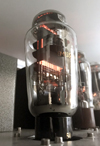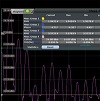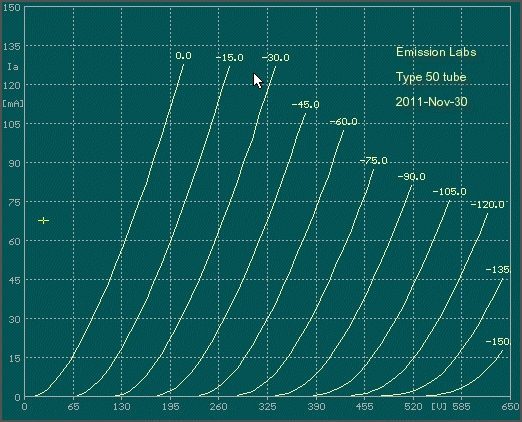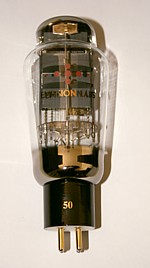Type 50 Data Sheet
Description
|
Introduced in 1928 by RCA, the historical 50 tube, was one of the first higher power triodes for Audio Applications. The curves of this tube are extremely nice, and so distortion will be very low, even at high signal. For that reason, it was originally recommended to use transformer coupling, which method is the safest for high output power circuits. Although the EML50 is much higher quality than the original 50 tubes, and the EML can safely be used capacitor coupled, you can stay closer to the original circuits and design ideas, by using transformer coupling. (Some circuits with the LL1660 will be added to a later version of this data sheet) |
Operation and operating points are identical to the historical 50, but it is also possible to use the EML at higher Anode dissipation, up to maximum 28 Watt continuous.
The quality of modern transformer cores is significantly higher than in the first days of tube production, and step-up coupling transformers can be found with perfect full HiFi properties. We recommend the Lundahl LL1660 Series here. These have a passive gain of 2.5 and seem the ideal combination with this tube.
Guarantee program for first owner.
The first owner can register the tube within 4 weeks after receival, at the Emission Labs ® website, to participate in the 5 years guarantee program, which is additional to the legal obligations of the seller.
Register here for the 5years guarantee
Features
- Gold Plated Grid
- Hard metal Construction (Note1)
- Extra large getters
- Hand blown Glass bulb
- Anti-microphonic Anode- and grid suspension
- These tubes are shipped in a high quality dual box
- Tube printing with real gold (metal), red color is glass burned into the glass
- Gold Plated pins, black ceramic socket. (White bottom.)
Sound Character of the EML 50
Specially intended for use with the historical type 50, the type 81 mono diode was introduced at that time. At EML we did the same thing, we introduced the 50 and the 81 together. In order to make a rectifier circuit, the classical way, just parallel the heaters of the 81 mono diode, and the result is a double diode, which is more powerful than a tube like 5U4G.
 According to Ing. Alesa Vaic, who was the first re-introduce the 300B in 1994 (under the Vaic Valve brand), DHT tube families, are soundwise characterized by their heater voltage. This explains the popularity of the European 4Volt tubes, like AD1, PX4, PX25, RE604, but also 2.5V tubes like 45 and 2A3 have their own fans. The 50 (and also the 81 mono diode) with it's 7.5V heater are a family of it's own for this reason.
According to Ing. Alesa Vaic, who was the first re-introduce the 300B in 1994 (under the Vaic Valve brand), DHT tube families, are soundwise characterized by their heater voltage. This explains the popularity of the European 4Volt tubes, like AD1, PX4, PX25, RE604, but also 2.5V tubes like 45 and 2A3 have their own fans. The 50 (and also the 81 mono diode) with it's 7.5V heater are a family of it's own for this reason.
 The EML50 is made with a boxed anode, which makes the tube larger than the RCA tube, and we get less distortion in return for that. This can already be seen by looking at the curves, which are simply excellent. Though there is a resemblance with 300B, the 50 is different. The 50 feels best at higher voltage and higher impedance. The of such tubes is softer, silkier, less dominant as a low gain tube like 300B.
The EML50 is made with a boxed anode, which makes the tube larger than the RCA tube, and we get less distortion in return for that. This can already be seen by looking at the curves, which are simply excellent. Though there is a resemblance with 300B, the 50 is different. The 50 feels best at higher voltage and higher impedance. The of such tubes is softer, silkier, less dominant as a low gain tube like 300B.
Something which influences the sound very much, is the option of the EML50, to exceed the Anode voltage of the RCA, which is possible because of the boxed anode of EML (vs the tiny construction of RCA).
 Here is a fantastic report about a 50 Amplifier, placed here with the friendly permission of Raymond Woerdman from Holland. It is in Dutch, perhaps you can find a way to translate it online.
Here is a fantastic report about a 50 Amplifier, placed here with the friendly permission of Raymond Woerdman from Holland. It is in Dutch, perhaps you can find a way to translate it online.
EML 50 Filament Ratings |
|
| Filament Voltage | 7.5Volt (AC or DC) |
| Electronic heater modules: | Only voltage source |
| Tolerance on filament voltage | 5% |
| Filament Current | 1.25Ampere |
| Maximum Time on Stand By (Heater voltage only) |
2 hours |
EML 50 Maximum Conditions |
|
| Anode Voltage |
500Volt
|
| Continuous Anode Dissipation |
28Watt
|
| Peak Anode Dissipation (Not continuous) |
35Watt
|
| Anode Current |
120mA
|
| Grid resistor with Auto Bias |
250k Ohm (note4) |
| Grid resistor with Fixed Bias |
50k Ohm (note4) |
EML 50 Factory Test conditions |
|
| Anode Voltage |
400V
|
| Anode Current |
55mA
|
EML 50 Typical Data |
||||
| Anode Voltage | 350V |
400V |
450V |
450V* |
| Anode Current | 45mA |
55mA |
55mA |
62mA |
| Anode Dissipation | 15.8Watt |
22Watt |
24.8 Watt |
28 Watt |
| Control Grid Voltage | 63Volt |
70Volt |
84Volt |
81Volt |
| Anode Impedance (Rp) | 1900 Ohm |
1800 Ohm |
1800 Ohm |
1800 Ohm |
| Amplification Factor | 3.8 |
3.8 |
3.5 |
3.5 |
| Transconductance (Gm) | 2mA/V |
2.1mA/V |
2.1mA/V |
2.1mA/V |
| Power Output in Class A | 2.4 Watt |
3.4 Watt |
4.6 Watt |
6 Watt |
| Load Impedance (Ra) | 4100 Ohm |
3670 Ohm |
4350 Ohm |
4100 Ohm |
| Lundahl SE Output Transformer | LL1679-70mA |
LL1620-60mA |
LL1679-70mA |
LL1679-70mA |
| ISO (formerly Tango) SE Output Transformer | FC-40-S |
FC-40-S |
FC-40-S |
FC-40-S |
| Lundahl Inter stage transformer ** | LL1660 |
LL1660 |
LL1660 |
LL1660 |
* Fourth table (450V/62mA) not allowed with historical tubes |
||||

Download these curves as PTE file - What is that?
EML 50 Mechanical Data |
|

|
Size including Socket (but excluding pins) 145 x 58 mm |
| Single Tube weight |
145 Gram |
|
Shipment weight for pair in gift box |
700 Gram |
Notes
- Hard-metals can be used in electron tubes, though these are more difficult to use, and more costly than classic nickel. Hard metal Anodes have a more precise Anode distance, and do not change shape when heated, or at mechanical shock. This ensures reproducible tube parameters, and long term stability. Wolfram grids allow the most precise grid wire distance, because wolfram is an extreme hard metal. Best grid geometry ensures uniformity and linearity of the tube curves.
- Individual Test data, such as: Matching Data, Grid Current, Vacuum, Filament Current, etc., are on the Certificate that is on the outside of the tube box. Each tube is numbered from the inside, with a metal Tag
- Average Plate Characteristics are made with the Sofia Digital Curve tracer.
- Do not experiment with lower filament voltage, to expect better lifetime. We already specify filament voltage for the best lifetime.
- Gold Plated grids have a few advantages, such as increased bias stability, some protection against accidental overload, and better linearity of tube curves.
